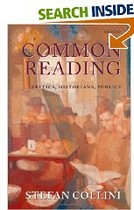writers, critics, intellectuals, and their audiences
Alternative titles for this collection of literary essays might be The Last Men of Letters, Critics and the Marketplace, or even (to choose the sub-titles of two other Stefan Collini books) Essays in History and Culture or Intellectuals in Britain – because it is largely a study of writers 1920-1960 who earned their living as journalists and critics in the world of literary magazines and journals. But Common Reading is also a consideration of their readership, how they have been forced to change over the years, and the state of intellectual biography in the twenty-first century.
 He describes the collection himself as ‘exercises in intellectual portraiture [and] the nature of the diverse public for whom these figures wrote, and … the cultural traditions and institutional frameworks within which they operated’. The first half of the book is a series of literary portraits of critics and what he calls ‘public intellectuals’ – Cyril Connolly, Edmund Wilson, George Orwell, E.H.Carr, E.P.Thompson, Perry Anderson, and even Roger Scruton.
He describes the collection himself as ‘exercises in intellectual portraiture [and] the nature of the diverse public for whom these figures wrote, and … the cultural traditions and institutional frameworks within which they operated’. The first half of the book is a series of literary portraits of critics and what he calls ‘public intellectuals’ – Cyril Connolly, Edmund Wilson, George Orwell, E.H.Carr, E.P.Thompson, Perry Anderson, and even Roger Scruton.
The second half is a series of extended essays on literary and intellectual culture as reflected in journals and magazines, including those for which he himself writes, such as the Times Literary Supplement. He speaks from deep within the cultural establishment – Professor of English at Cambridge – but the essays are pitched at the same level as the work he is describing: that is, they are well informed without being overly academic, and accessible to the common reader without being over-simplified or condescending. I was interested to see that he endorsed Perry Anderson’s critique of contemporary academic writing as suffering from ‘peer-group fixation, index-of-citations mania, gratuitous apparatuses, pretentious jargons, [and] guild conceit’.
This is not to say that he is against scholastic rigour. His essay on two biographies of George Orwell offers a bravura display of examining the value of literary evidence in making factual or historical claims about a personal life. He makes similar analyses on the ‘Art of Biography’ (as Virginia Woolf calls it in her essay on the subject) in the case of a critical account of the successful-but-ineffectual Stephen Spender written by John Sutherland.
He also does an excellent line in biography as critical reassessment. There’s a devastating piece on Andre Malraux – art-thief, self-appointed hero of a war he avoided, and non-elected politician – which has one wondering how anybody was taken in by such frauds in the first place. Similarly with the living, his analysis of Roger Scruton (Hegel in Green Wellies, Roger of Salisbury) leaves the fustian so-called philosopher in tatters at the end of half a dozen pages.
The style of Collini’s writing is something of a curious mixture. He embraces the long cadences and deeply nested qualifying clauses of the early twentieth century in which he is clearly so well read. But his jokes, casual references, and asides are offered in a pungently modern fashion. He’s writing for an intellectual audience, and he expects you to keep up.
He’s dealing with the same sort of issues as John Carey in The Intellectuals and the Masses – the relationship of intellectuals to the audiences which consumed their work. And like Carey he offers fascinating glimpses into the social and political culture of the literary professional – complete with how much they earned, how many books they sold, and how their critical reputations have risen (and often fallen again) in the last half century.
These are studies in literary and cultural history of a very high order. I’m slightly embarrassed to admit that I hadn’t come across Collini’s work before, but I now look forward to working my way through his considerable back catalogue.
© Roy Johnson 2010
Stefan Collini, Common Reading, Oxford: Oxford University Press, 2009, pp.384, ISBN: 0199569797
More on literature
More on the novella
More on literary studies
More on short stories